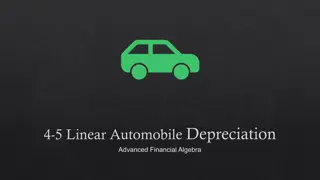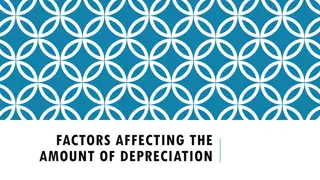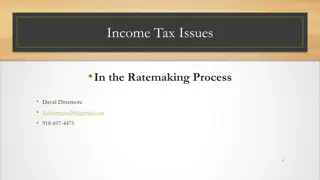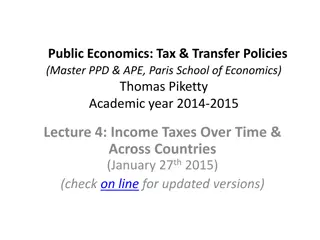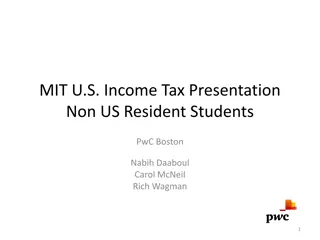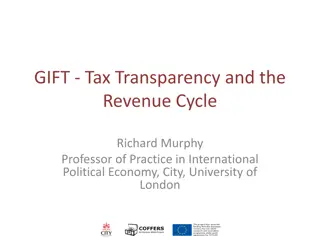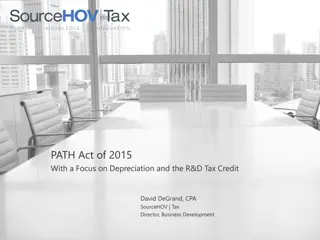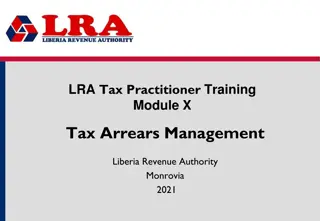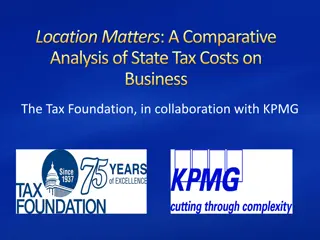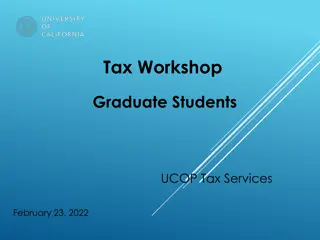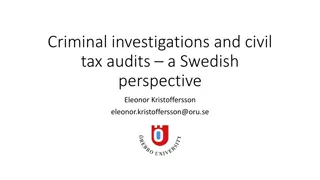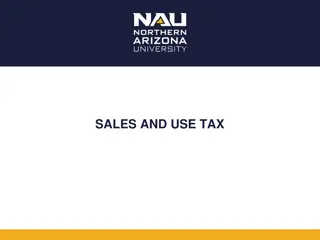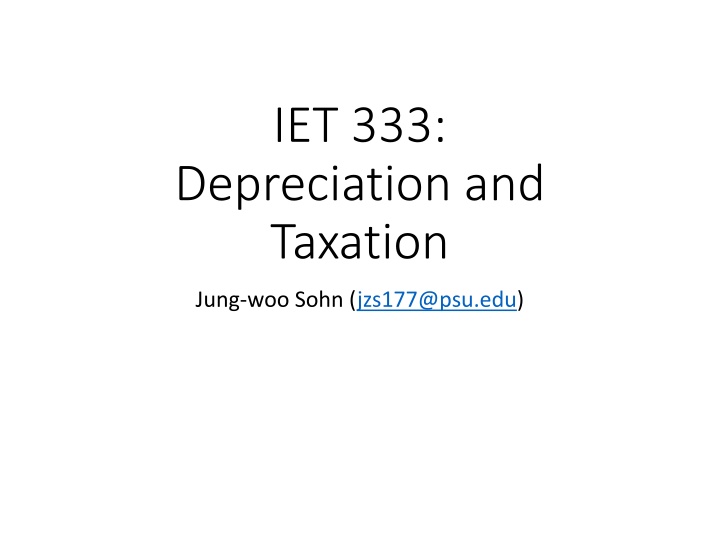
Depreciation and Taxation in Business
Learn about depreciation, its causes, terminology, and calculation methods. Explore how depreciation impacts asset value and business taxation, with practical examples and insights. Prepare yourself for effective financial management.
Download Presentation

Please find below an Image/Link to download the presentation.
The content on the website is provided AS IS for your information and personal use only. It may not be sold, licensed, or shared on other websites without obtaining consent from the author. If you encounter any issues during the download, it is possible that the publisher has removed the file from their server.
You are allowed to download the files provided on this website for personal or commercial use, subject to the condition that they are used lawfully. All files are the property of their respective owners.
The content on the website is provided AS IS for your information and personal use only. It may not be sold, licensed, or shared on other websites without obtaining consent from the author.
E N D
Presentation Transcript
IET 333: Depreciation and Taxation Jung-woo Sohn (jzs177@psu.edu)
Announcements: No class on next Thursday (December 11th) Instead, we will have a class time on Wednesday evening (December 10th) Around 6pm? Topic: Final review Pizza will be served!
Depreciation Depreciation: Decrease in value of an asset Depreciation caused by: New products, technological innovations, etc. Usually capital equipment Machinery Depreciation amount: Determined by the market Or your own estimation/prediction
Depreciation example: Used car value example Source: http://livingstingy.blogspot.com/2012/04/cars-with-low-depreciation-self.html
Depreciation: Terminology Asset Resource used in business Useful life Duration of time resources are expected to be in use Market value The value what the asset can be disposed of at the time of sale Book value: prediction/estimation The value what the owner needs to sell (to avoid a loss) Starts from the first cost Relationship to tax: Depreciation is regarded to contribute to the production of goods Non-taxable
Depreciation: terminology Depreciation cost: accumulates over the years
Depreciation: Straight-line depreciation Same depreciation cost every year: Total depreciation: P S Annual depreciation: (P S) / N
Depreciation: Straight-line depreciation Example: A robot costs $25,000. At the end of four- year useful life its salvage value is estimated to be $5,000. Prepare its depreciation schedule under the straight-line method. P = $25,000, S = $5,000, N = 4 Therefore, annual depreciation: (25,000 5,000) / 4 = 5,000
Depreciation: SOYD method Straight-line depreciation: simple but unrealistic Depreciation cost highest at first, gets lower later Any possible modification to the straight-line method? SOYD method: Sum-of-Years-Digits method Depreciation: ????????? ?????? ???? ???? For example, if the useful life is 4 years First year depreciation: ? ? 3 1 + 2 + 3 + 4 (? ?) 2 1 + 2 + 3 + 4 (? ?) 1 1 + 2 + 3 + 4 (? ?) Second-year depreciation: Third-year depreciation:
Depreciation: Declining balance with SOYD method
Depreciation: SOYD method Example: A robot costs $25,000. At the end of four- year useful life its salvage value is estimated to be $5,000. Prepare its depreciation schedule under the SOYD method. SOYD = 1 + 2 + 3 + 4 = 10 years P S = 25,000 5,000 = 20,000 Depreciation rates: 1st year: 4/10 2nd year: 3/10 3rd year: 2/10 4th year: 1/10 Depreciations: 1st year: 4/10 * 20,000 2nd year:3/10 * 20,000 3rd year: 2/10 * 20,000 4th year: 1/10 * 20,000
Depreciation: SOYD method Example: A robot costs $25,000. At the end of four-year useful life its salvage value is estimated to be $5,000. Prepare its depreciation schedule under the SOYD method. Year Beginning Book Value Depreciation Ending Book Value 1 $25,000 20,000 * 0.4 = 8,000 $17,000 2 17,000 20,000 * 0.3 = 6,000 11,000 3 11,000 20,000 * 0.2 = 4,000 7,000 4 7,000 20,000 * 0.1 = 2,000 5,000 Total: 20,000
Depreciation: Double-declining balance method Declining balance method Charges a fixed percentage of the asset s book value Most realistic Double-declining balance (DDB) method Uses 200% or 150% rates for decline With respect to the N periods Depreciation for N-year project First-year depreciation: 2 Second-yr depreciation:2 Third-yr depreciation: ? First-year book value ? Second-year book value 2 ? Third-year book value
Depreciation: DDB method Example: A robot costs $25,000. At the end of four-year useful life its salvage value is estimated to be $5,000. Prepare its depreciation schedule under the DDB method. Depreciation rate: 2/N = 2/4 = 0.5 Year Beginning book value Depreciation Ending book value 1 $25,000 $12,500 = $25,000 * 0.5 $12,500 = $25,000 - $12,500 2 12,500 6,250 = 12,500 * 0.5 6,250 = 12,500 6,250 3 6,250 3,125 = 6,250 * 0.5 3,125 = 6,250 3,125 4 3,125 1,563 = 3,125 * 0.5 1,562 = 3,125 1,563 Total = $23,438 Ending book balance: 1562 < 5000?????
Depreciation: DDB method How to compensate the loss below the salvage value estimation? Stop applying DDB at certain points Switch to straight-line method in the middle
Depreciation: Switching to linear depreciation
Depreciation: Comparison of different methods
Depreciation: Accelerated cost recovery system (ACRS) Why ACRS? To tackle the cons of the depreciation methods so far SYOD: Depreciation is not realistic DDB: Depreciation realistic but problem with the salvage value The idea for ACRS: Consider a set of depreciation rates with Accelerated decline Converging to the estimated salvage value MACRS (Modified Accelerated Cost Recovery System)
Depreciation: MACRS (Modified Accelerated Cost Recovery System) Depreciation categories and rates predetermined Usually by the government
Depreciation: MACRS example Determine the depreciation schedule for a $20,000 workstation computer as per MACRS. Category: 5-year one Rates: Look up in the MACRS table
Tax: taking out depreciation cost In corporate tax Gross income = Sales revenue operating cost Taxable income = Gross income Depreciation expenditures Depreciation is regarded as directed to production Incremental tax rate: for corporates Tax amount for $60,000 income 10% for the first $50,000 = $5,000 15% for the remaining $10,000 = $1,500 Total amount of tax: $6,500 Taxable Income Rate Up to $50,000 10% $50,000 - $75,000 15% $75,000 - $100,000 20% Beyond $100,000 25%
Tax: example A small job shop s revenue for the last year was $782,552, while its operating costs were $458,760. The shop acquired a new CAM system for its numerically controlled machines at a cost of $125,000. The CAM system s useful life is expected to be three years and the salvage value is $20,000. Assuming straight-line depreciation, how much income tax is due? (Use the tax rate table from the previous slide)
Tax: example Solution: Gross income = Sales revenue Operating cost = 782,552 458,760 = 323,792 Taxable income = Gross income Depreciation expense = 323,792 (125,000 20,000) / 3 = 323,792 35,000 = 288,792 Application of tax rates: incremental 10% up to $50,000: 15% up to additional $25,000: 20% up to additional $25,000: 25% for the remaining $188,792: = 47,198 And sum them up! The income tax due is $60,948 = 5,000 = 3,750 = 5,000

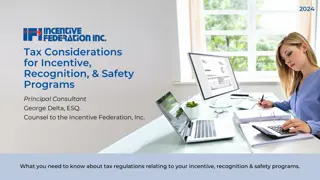
![Town of [Town Name] Real Estate Tax Rates and FY 2024 Budget Summary](/thumb/62211/town-of-town-name-real-estate-tax-rates-and-fy-2024-budget-summary.jpg)




